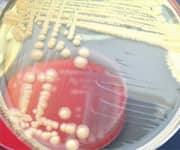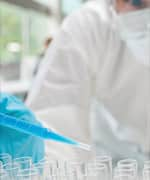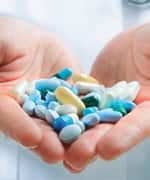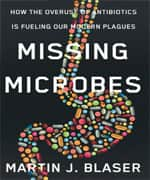Life Extension Magazine®
How The Overuse Of Antibiotics Is Fueling Our Modern Plague
Your body is comprised of an estimated 30 trillion human cells, but it is host to more than 100 trillion bacterial and fungal cells, the friendly microbes that co-evolved with our species. In fact, 70 to 90% of all cells in the body are nonhuman.
For hundreds of thousands of years, human cells and bacterial cells have peacefully coexisted in a symbiotic state that contributed to the health and equilibrium of the human body. But the extensive overuse of antibiotics since their discovery and subsequent production in the last century has spurred the rise of “superbugs,” which are resistant to several kinds of antibiotics. Superbugs infect over 2 million people in the US every year, and kill about 23,000, according to the Centers for Disease Control and Prevention (CDC).
Microbiologist Dr. Martin J. Blaser, Director of the Human Microbiome Program at NYU and author of Missing Microbes: How the Overuse of Antibiotics Is Fueling Our Modern Plagues, believes the overuse of antibiotics actually goes even further, and contributes to a host of modern maladies, including diabetes, obesity, asthma, allergies, and certain kinds of cancers.
In this exclusive interview with Life Extension®, Dr. Blaser discusses antibiotic overuse and what we can do to prevent and solve even more catastrophic health problems in the near future—which he refers to as an “antibiotic winter”—as well as ways to stop the destruction and decline of beneficial bacteria.
LE: Let’s begin with the basics and talk about what microbiomes are and why they play such a crucial role in our health.
MB: Think about your vital organs…your heart, brain, lungs, kidneys, and liver are complex structures that carry out essential functions that keep you alive. But what if I were to tell you that you have another vital “organ” that helps keep you alive but you’ve never seen. It’s all over you, especially inside you…
Perhaps most remarkable is that it seems completely alien. It doesn’t derive from your obviously human cell line. Rather it’s composed of trillions of tiny life forms. The microbes inside you are not a random mix of all species on Earth; every creature has co-evolved with its own collection of microbes that carry out many metabolic and protective functions. In other words, they work for us.

LE: Why are these trillions of microbes so important?
MB: Probably the most important service your microbes provide is immunity. In fact, your microbes constitute an important third arm of the immune system. First, there is innate immunity, based on the fact that most of the microbes with which we’re in contact have structural patterns that are seen by proteins and cells that guard our surfaces. Then, adaptive immunity is based on the recognition of highly specific chemical structures. Microbial immunity is based on the microbes that are already in your body—your long-term residents—inhibiting outsiders through various mechanisms.
LE: When Alexander Fleming discovered penicillin in 1928, it was called a miracle drug that would bring about a new era of medicine.
MB: Penicillin ushered in a golden age in medicine. Then came others: tetracycline, erythromycin, chloramphenicol, and isoniazid, which brought about the antibiotic era. Formerly lethal diseases could be cured. Almost all great advances in medicine from the second half of the 20th century continuing through today were catalyzed by the development of antibiotics. No harm could come from their use, or so it seemed.
The fallout only came later.
LE: You believe the overuse of antibiotics has altered the delicate balance of microbes living in all of us, and this makes us vulnerable to a wide range of diseases that you call today’s modern plagues.
MB: Since WWII, which is about when antibiotics were introduced, we’ve had the big rise in many diseases: obesity, diabetes, juvenile diabetes, inflammatory bowel disease, allergies... I believe there is one cause that is underneath it all, and that is a change in our ancient microbiome.
LE: We went from the golden age of medicine to the dramatic overuse of these drugs in a relatively short time period. What led to such a drastic overuse of antibiotics?
MB: Because they were so effective and apparently free of obvious risk, doctors and patients alike began to ask: Can’t we solve this problem with antibiotics? The answer, very often, was yes.
I’m not questioning the efficacy of antibiotics on the small minority hospitalized with pneumonias, puerperal sepsis, meningitis, and other severe infectious diseases but rather on millions of healthy people with less serious infections and minor complaints, such as runny nose and skin infections. Tens of millions are prescribed antibiotics in the US alone. The problem is particularly perilous for our children. They are vulnerable in ways we never saw.

LE: How does our overuse of antibiotics harm our children?
MB: The most obvious example of the extravagant use of antibiotics is for the common disorders known as upper respiratory infections…sore throats, runny noses, earaches, sinus pain, and misery. But they are mainly caused by viruses…and antibiotics like penicillin don’t work on them.
The magnitude of antibiotic use is enormous and has crept up year after year. By 2010, health-care providers prescribed 258 million courses of antibiotics to people in the US. The highest rate was for children under the age of 2: 1,365 courses per 1,000 babies. The average American child received nearly three courses of antibiotics in his or her first two years of life. They go on to receive another eight courses over the next eight years. Young adults receive, on average, another 13 courses before the age of 40.
The first problem from the overuse of antibiotics was resistance. Simply, the more often we put antibiotics in our bodies and our children’s bodies, the more likely we select for bacteria that are resistant to their action. Here’s one way it works: A child receives amoxicillin. When it’s swallowed, it enters the bloodstream and travels to all organs and tissues—stomach, lungs, mouth, throat, skin, ears, and in girls, vagina—destroying bacteria. Now we are in trouble. When susceptible species are diminished or killed, population of resistant bacteria expand. With fewer competitors around, resistant bacteria flourish.
LE: This will allow disease to flourish more quickly and spread.
MB: Some infections today are untreatable with current antibiotics and more likely to evolve. A second crisis is looming: the failure of pharmaceutical firms to develop new antibiotics to keep up with the resistance.
LE: Broad-spectrum antibiotics that kill many types of microbes are not the answer. What is?
MB: Very few narrow-spectrum drugs exist. We need to create and test them. If we want an antibiotic specific for Streptococcus pneumonia, we have to identify a target in that organism shared by few, if any, other bacteria. Same for Staph aureus. The good news is that it should be relatively simple to develop [them].
LE: Even if we decide to stop taking antibiotics for every common cold and ailment, won’t we still be exposed to them in the foods we eat?
MB: Antibiotics arrive in our food, particularly in meats, milk, cheeses, and eggs. Foods are allowed maximum residue limits for antibiotics, establishing upper boundaries of what is permitted. For example, milk can legally have up to 100 micrograms of tetracycline per kilogram. This means a child who drinks two cups of milk a day will ingest about 50 micrograms every day. That’s not a lot, but consider that many children drink milk every day, year after year. And that’s just tetracycline. A 1990 report indicated that 30 to 80% of milk samples had detectable antibiotics, especially sulfa drugs and tetracycline. Surveys showed legal limits were exceeded 9% of the time in meats, milk, and eggs.
LE: In what other ways are we unknowingly exposed to antibiotics?
MB: Most people who say they haven’t had an antibiotic in years are mistaken. Antibiotics are found in water. Current purification treatments are excellent for removing harmful bacteria and viruses, but don’t fully remove antibiotics. The amounts [are] small but it all adds up.
Densely farmed commercial fish, such as salmon, tilapia, and catfish as well as shrimp and lobster, are given relatively high doses of antibiotics, not for growth [but] to combat disease associated with crowded conditions in which they’re raised. As with livestock, the FDA requires a washout period, but fish raised domestically are rarely inspected. Fish and shellfish from Asia are more tainted.

LE: You are quick to stress that you are not anti-antibiotics.
MB: I’m not against antibiotics any more than I’m against ice cream—both are great at serving their purpose—but sometimes there can be too much of a good thing. We must curb our appetites for these powerful drugs. This is the biggest, simplest, and most achievable step we can take in the short term. It won’t turn back the clock, but it could help slow the daily carnage to our microbial diversity.
Each of us can take responsibility for how to deal with antibiotics. Tell your doctor you want to wait a few more days before taking amoxicillin for that cough. Or you want to wait another day before you get a prescription for your child with a head cold. Resist pushing your physician for a quick fix to mitigate your anxiety. Without parental pressure, your doctor can make a better judgment about the need for an antibiotic.
LE: But parents will continue to worry about a sick child and want to rush to the doctor.
MB: I’m not saying wait and see in every instance. Sometimes children are quite ill and should be examined immediately. They are fussy, run high fevers, and gasp for breath. Or they’re listless and don’t respond normally to light or sound. Their bellies may be swollen. They may have severe diarrhea or a terrible rash. These are true emergencies. At a time like this, parents should reconstruct the events leading up to the onset of symptoms and tell the physician what they recall. After the exam, many acutely ill children will need antibiotics immediately to avoid permanent injury or save their lives. It would be a terrible mistake for a doctor to delay treatment out of concert for causing collateral damage to resident microbes.
LE: Are there any other ways we can help slow down the spread of superbugs?
MB: Inform your dentists you don’t want antibiotics unless he or she can convince you the benefits outweigh the risk. Stop using so many sanitizers on yourself and your kids. While the key ingredient, triclosan, is not an antibiotic, it kills bacteria on contact. What’s wrong with good old soap and water?

Missing Microbes,
call 1-800-544-4444.
Item #33874
One thing the government can do to reduce overuse of antibiotics [is] prevent farmers from giving them to animals whose products we eat. The carryover of antibiotics into our food and water is completely avoidable.
If you have any questions on the scientific content of this article, please call a Life Extension® Health Advisor at 1-866-864-3027.
Martin J. Blaser, MD, is Past President of the Infectious Diseases Society of America and Founder of the Foundation for Bacteriology and the Virtual Museum of Bacteria. He served as Chair of the Board of Scientific Counselor of the National Cancer Institute, and of the Advisory Board for Clinical Research at the NIH. He was elected to the Institute of Medicine of the National Academy of Sciences in 2011. He is a member of the editorial boards of Cell Host and Microbe, mBio, Helicobacter, Emerging Infectious Diseases, Gut, and Microbiome.

